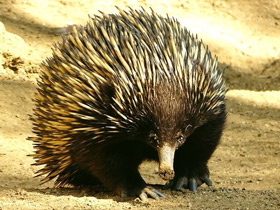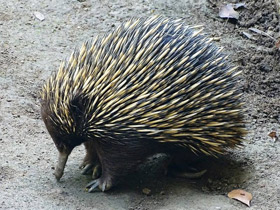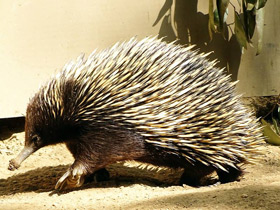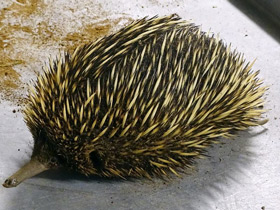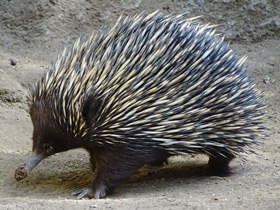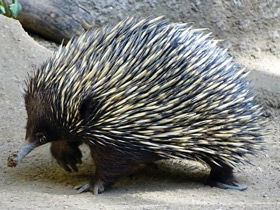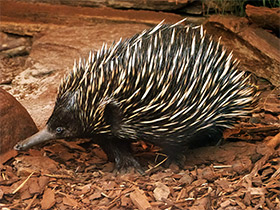The short-beaked echidna (Tachyglossus aculeatus), the short-nosed echidna
Short-beaked echidna видео
The short-beaked echidna (Tachyglossus aculeatus), also called the short-nosed echidna, is one of four living species of echidna and the only member of the genus Tachyglossus.
Taxonomy and naming
The short-beaked echidna was first described by George Shaw in 1792. He named the species Myrmecophaga aculeata, thinking that it might be related to the giant anteater. Since Shaw first described the species, its name has undergone four revisions: from Myrmecophaga aculeata to Ornithorhynchus hystrix, Echidna hystrix, Echidna aculeata and finally, Tachyglossus aculeatus. The name Tachyglossus means 'quick tongue', in reference to the speed with which the echidna uses its tongue to catch ants and termites, and aculeatus means 'spiny' or 'equipped with spines'.
The short-beaked echidna is the only member of its genus, sharing the family Tachyglossidae with the extant species of the genus Zaglossus that occur in New Guinea. Zaglossus species, which include the western long-beaked, Sir David's long-beaked and eastern long-beaked echidnas, are all significantly larger than Tachyglossus aculeatus, and their diets consist mostly of worms and grubs rather than ants and termites. Species of the Tachyglossidae are egg-laying mammals; together with the related family Ornithorhynchidae, they are the only extant monotremes in the world.
The five subspecies of the short-beaked echidna are each found in different geographical locations. The subspecies also differ from one another in their hairiness, spine length and width, and the size of the grooming claws on their hind feet.
- Tachyglossus aculeatus acanthion is found in the Northern Territory and Western Australia.
- Tachyglossus aculeatus aculeatus is found in Queensland, New South Wales, South Australia and Victoria.
- Tachyglossus aculeatus lawesii is found in coastal regions and the highlands of New Guinea, and possibly in the rainforests of Northeast Queensland.
- Tachyglossus aculeatus multiaculeatus is found on Kangaroo Island.
- Tachyglossus aculeatus setosus is found on Tasmania and some islands in the Bass Strait.
The earliest fossils of the short-beaked echidna date back around 15 million years ago to the Miocene epoch, and the oldest specimens were found in caves in South Australia, often with fossils of the long-beaked echidna from the same period. The ancient short-beaked echidnas are considered to be identical to their contemporary descendants except the ancestors are around 10% smaller. This "post-Pleistocene dwarfing" affects many Australian mammals. Part of the last radiation of monotreme mammals, echidnas are believed to have evolutionally diverged from the platypus around 66 million years ago, between the Cretaceous and Tertiary periods. However, the echidna's pre-Pleistocene heritage has not been traced yet, and the lack of teeth on the fossils found thus far have made it impossible to use dental evidence.
The short-beaked echidna was commonly called the spiny anteater in older books, though this term has fallen out of fashion since the echidna is only very distantly related to the true anteaters. It has a variety of names in the indigenous languages of the regions where it is found. The Noongar people from southwestern Western Australia call it the nyingarn. In Central Australia southwest of Alice Springs, the Pitjantjatjara term is tjilkamata or tjirili, from the word tjiri for spike of porcupine grass (Triodia irritans). The word can also mean 'slowpoke'. In the Wiradjuri language of Central NSW, it is called wandhayala.
In the central Cape York Peninsula, it is called (minha) kekoywa in Pakanh, where minha is a qualifier meaning 'meat' or 'animal', (inh-)ekorak in Uw Oykangand and (inh-)egorag in Uw Olkola, where inh- is a qualifier meaning 'meat' or 'animal'. In the highland regions of southwestern New Guinea, it is known as the mungwe in the Daribi and Chimbu languages. The short-beaked echidna is called miɣu in the Motu language of Papua New Guinea.
Origin
Tachyglossus aculeatus is a species of monotreme mammal. It is one of four living species of echidna (Tachyglossidae) and the only one of the genus Tachyglossus.
This species was first described in 1972 by the English zoologist George Shaw (he also described the platypus a few years later). Shaw gave it the name Myrmecophaga aculeata, mistakenly referring to this strange long-necked animal trapped in an anthill as an ant-eater. Ten years later, the anatomist Edward Home discovered that echidnas and platypuses had a cloaca, which serves as an opening for the intestines, ureters and reproductive tract. This was the basis for the classification of monotremes. The generic name echidna translates from Greek as "quick tongue"; the generic name is "spiny".
Appearance and peculiarities
The body length of Tachyglossus aculeatus varies from 30 to 45 cm, and its weight from 2.5 to 5 kg. The Tasmanian subspecies is slightly larger, up to 53 cm. The head of Tachyglossus aculeatus is covered with thick hair; the neck is short, almost invisible on the outside; the pinnae are not visible. The snout of Tachyglossus aculeatus is elongated into a narrow "beak" 75 mm long, straight or slightly curved. It represents an adaptation for finding prey in narrow crevices and burrows, from where the echidna reaches them with its long sticky tongue. The mouth opening at the end of the beak is toothless and very small, opening no more than 5 mm. Like the platypus, the echidna's "beak" is highly innervated. Its skin contains both mechanoreceptors and special cells - electroreceptors - with which the echidna picks up the faint vibrations of the electric field that occur when small animals move. No other mammal, apart from echidnas and platypuses, has this electrolocalisation organ.
The limbs of Tachyglossus aculeatus are shortened. The toes are equipped with powerful flat claws, adapted for digging into the ground and breaking through termite walls. The claws are elongated on the hind legs; the echidna uses them to clean hair and scrape off vermin. Adult males also have a small spur on the hindquarters, similar to that of the platypus, but smaller and not associated with a venom gland.
The back and sides of Tachyglossus aculeatus are covered with short, stiff, hollow spines. They reach a length of 5-6 cm; they are yellow with black tips, less often completely yellow. The needles are modified hairs and consist mainly of keratin. The coat of Tachyglossus aculeatus is brown or black, coarse; it partially covers the needles. Its tail is very short, resembling a small protrusion.
As in all monotremes, faeces, urine and sexual products of Tachyglossus aculeatus are excreted through a single orifice, the cloaca. A brood pouch appears on the abdomen of females after parturition. The musculature of Tachyglossus aculeatus is quite characteristic. The specific muscle panniculus carnosus, which lies under the skin and covers its entire body, allows Tachyglossus aculeatus to curl into a ball, hiding its abdomen and exposing its spines.
The musculature of the snout and tongue of Tachyglossus aculeatus is highly specialised. Its tongue is able to extend 18 cm outside the mouth (its total length reaches 25 cm). It is covered with mucus to which ants and termites adhere. The tongue protrudes by contracting the circular muscles, which change its shape and push it forward, and the two sublingual muscles that attach to the root of the tongue and to the lower jaw. The protruding tongue becomes stiffer due to the rapid influx of blood. Its retraction is ensured by the two longitudinal muscles. The tongue is able to move at a high speed of up to 100 movements per minute. Tachyglossus aculeatus has poor eyesight, but a well-developed sense of smell and hearing. Their ears are sensitive to low-frequency sounds, allowing them to hear termites and ants under the ground. The brain of Tachyglossus aculeatus is better developed than that of the platypus and has more gyrus.
Habitat
This is a terrestrial animal, although it can swim and cross fairly large bodies of water. It occurs in any landscape that provides sufficient food, from humid forests to dry scrublands and even deserts. It is also found in mountainous areas, where there is snow for part of the year, on agricultural land and even in metropolitan suburbs. Tachyglossus aculeatus is mainly active during the day, but warm weather causes it to switch to a nocturnal lifestyle. Tachyglossus aculeatus is poorly adapted to heat, as it has no sweat glands and its body temperature is very low, 30-32 °C. In hot or cold weather it becomes lethargic; in severe cold it hibernates for up to 4 months. Subcutaneous fat reserves allow Tachyglossus aculeatus to starve for a month or more if necessary.
Nutrition
Tachyglossus aculeatus feeds on ants, termites, less often other insects, small molluscs and worms. It digs anthills and termite mounds, digs in forest litter with its nose, strips bark from fallen and rotting trees, and shifts and turns over stones. When it finds insects, Tachyglossus aculeatus launches its long, sticky tongue, to which its prey clings. Tachyglossus aculeatus has no teeth, but has keratinous teeth on the root of its tongue, which rub against the roof of its mouth in a comb-like fashion and thus grind up food. In addition, Tachyglossus aculeatus, like birds, swallows soil, sand and small stones, which complete the crushing of food in the stomach.
Life history
Tachyglossus aculeatus leads a solitary lifestyle (except during the mating season). It is not a territorial animal: Tachyglossus aculeatus encountered simply ignore each other; they do not establish permanent dens or nests. Tachyglossus aculeatus rests in any convenient place: under roots, stones and in the hollows of fallen trees. Tachyglossus aculeatus runs little. The main defence of Tachyglossus aculeatus is spines; the disturbed echidna rolls itself into a ball like a hedgehog and, if it has time, partially buries itself in the ground, exposing its back to the enemy with raised needles. It is very difficult to drag Tachyglossus aculeatus out of the dug hole, as it relies heavily on its legs and needles. The sounds emitted by the disturbed echidna resemble a soft growl. Interestingly, Tachyglossus aculeatus has one of the largest fleas, reaching a length of 4 mm.
Reproduction
Tachyglossus aculeatus lives so secretly that details of its mating and breeding behaviour were not published until 2003, after 12 years of field observations. It was found that during the courtship period, which lasts from May to September (the timing of courtship varies in different parts of the species' range), these animals remain in groups consisting of one female and several males. Both females and males emit a strong musky scent during this time, allowing them to seek each other out. The group feeds and rests together; when on the move, the echidnas follow in single file, forming a "train" or caravan. The female leads, followed by 7-10 males. Courtship lasts up to 4 weeks. When the female is ready to mate, she lies down and the males start circling around her, throwing clumps to one side. After a while, a real trench 18-25 cm deep forms around the female. The males push each other violently, driving each other out of the trench until there is only one winning male left inside the ring. If there was only one male, the trench is straight. Mating (sideways) lasts about an hour.
Pregnancy in Tachyglossus aculeatus lasts 21-28 days. The female builds a brood hole, a warm, dry chamber, often dug under an empty anthill, a termite mound or even under a pile of garden debris near a human dwelling. The clutch usually contains a single leathery egg 13-17 mm in diameter and weighing just 1.5 g. How Tachyglossus aculeatus transfers the egg from the cloaca to the brood pouch has long been a mystery; its mouth is too small and its legs are clumsy. Presumably, when laying, the echidna deftly curls itself into a ball, with the skin of its abdomen forming a fold that secretes a sticky fluid. As it hardens, it glues the egg that was laid to its belly and shapes the pouch at the same time.
After 10 days, a tiny puggle hatches: it is 15 mm long and weighs only 0.4-0.5g. When it hatches, the puggle breaks the eggshell with a horny cone on its nose, analogous to the egg tooth of birds and reptiles. The eyes of the newborn echidna are hidden under the skin and the hind legs are virtually undeveloped. The front legs, however, already have well-developed toes. With them, the newborn passes from the back of the pouch to the front in about 4 h, where there is a special area of skin called the milky field or areola. This area has between 100 and 150 pores of milky glands; each pore is provided with a modified hair. When the puppy squeezes these hairs with its mouth, the milk enters its stomach. The high iron content gives echidna milk its pink colour. The young of Tachyglossus aculeatus grow very rapidly, increasing in just two months to 800-1000 times their weight, i.e. up to 400g. The young remains in its mother's pouch for 50-55 days, until it is old enough to develop spines. After that, the mother leaves it in a shelter and comes to feed it every 5 to 10 days until it is 5 to 6 months old. In total, nursing lasts 200 days. Between 180 and 240 days, the young echidna leaves the den and begins to live an independent life. Sexual maturity occurs at 2 to 3 years of age. Tachyglossus aculeatus breeds only once every two years or less frequently; according to some reports, once every 3-7 years. But its low reproductive rate is compensated by its long life span. In the wild Tachyglossus aculeatus survives up to 16 years; in captivity up to 45 years (one case).
Threats to existence
Tachyglossus aculeatus is common in Australia and Tasmania and is not an endangered species. It is less affected by land clearing, as Tachyglossus aculeatus has no particular habitat requirements apart from sufficient food. Its main threat comes from vehicles and habitat destruction, resulting in habitat fragmentation. Tachyglossus aculeatus tolerates captivity well, but does not breed. Tachyglossus aculeatus has only been able to produce offspring in five zoos, but in no case have the offspring survived to adulthood.

















